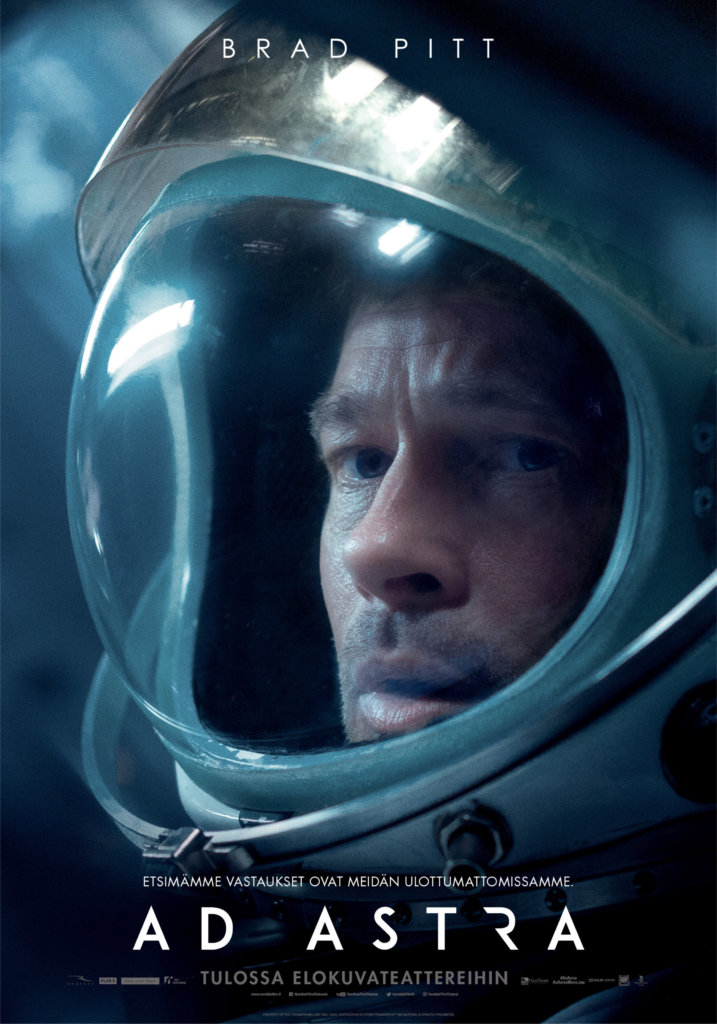
License required for the public film screening
According to the Finnish Copyright Act, public screening of the film requires permission. With the movie license annual permit, you can present the service's software from a source intended for private use of your choice.
Ad Astra
2019 | 123 min | K-12 | adventure, drama, sci-fi, thriller
Humanity is threatened by strange attacks that come from space. Astronaut Roy McBride (Brad Pritt) goes deep into space to find the reason for the attacks and at the same time to find his father who disappeared decades ago. On his way, Roy faces an unprecedented threat.
Koulukino’s learning material deals with polyphony, language methods for creating a personal image, information search, writing, analysis tasks, and philosophy discussion tasks. The learning material is aimed at secondary school studies.

© Materials by Elokuvalisenssi.fi
Pre-task:
Before the start of the movie, students should be asked to pay attention to the religious references found in the film and write them down during the movie.
After watching the movie, you can have a discussion about the following questions:
Religion:
- What religious references can be found in the movie? What do the religious references in the film convey?
- How is the relationship between science and religion portrayed in the movie?
- How do the main characters in the movie deal with their relationship with space and their place in the world?
- What religious references were used in the movie, such as the patron saint of travelers, Saint Christopher?
- Can the message of the movie be interpreted as a depiction of the search for meaning and God by modern humans? Why?
Psychology:
- How is Roy McBride’s relationship with his father portrayed in the movie?
- How does Roy McBride initially deal with his own emotions and his relationship with his father in the movie’s beginning?
- How does Roy McBride’s relationship with his father change when he discovers the true course of events?
- How is Roy McBride’s relationship with his ex-wife depicted at the beginning of the movie?
- How might the relationship between Roy McBride and his ex-wife change towards the end of the movie?
- How does the movie’s title, “Ad Astra,” reflect the psychological development of the movie’s main character?
After watching the movie, you can also do the following tasks:
1.Small group task on religious references and themes in popular culture in the movie “Ad Astra.”
After watching the movie, divide the students into groups. Ask them to brainstorm in small groups about the movie’s topics:
-Identifying religious themes: List in your group the scenes or elements in the movie that refer to religious themes. You can consider direct quotes from the characters’ dialogues, symbolism, character development, or the movie’s broader message about humanity’s place in the universe.
-Comparing to religious narratives: Compare the movie’s themes and events to traditional religious narratives, such as biblical stories or other religious legends. Consider how the movie may reflect or alter these narratives.
-Personal struggles of characters: Analyze the personal difficulties and conflicts of the protagonist, Roy McBride, from the perspective of religious themes. Can his journey be interpreted as a spiritual quest? Justify your answer within your group. Students can discuss these topics through these questions:
- Which religions can you find references to in the movie?
- How does the phrase “sons pay for the sins of their fathers” relate to the Bible, and how is it addressed in the movie?
- How do the movie’s characters perceive their own significance in relation to God and the search for truth?
- The movie has been said to depict the search for an absent God. Do you agree with this theme? How do you justify your view based on the events of the movie?
Ask students to summarize their discussions, which will be presented to other groups.
Consider how different groups interpret the movie’s themes. You can discuss the following questions:How does the movie address the search for the meaning of human life and personal significance in a religious context?
2.Small group work on Astronaut Roy McBride and his relationship with his father.
While watching the movie, pay special attention to the relationship between the main character and his father. Ask students to take notes or make observations about key scenes. After watching the movie, divide the students into groups of 3-4. Ask them to consider the movie’s themes in their small groups:
-Father and son interaction: Analyze the scenes in the movie where the father and son interact. Discuss how themes of abandonment and distance are portrayed in these scenes.
-Significance of the abandonment experience: In your group, reflect on how the father’s abandonment and physical distance affect Roy’s psychological and emotional state. How does the abandonment experience impact his identity and self-esteem?
-Coping mechanisms: Analyze how Roy copes with the experience of abandonment. How do his coping mechanisms manifest in his behavior, decisions, and relationships?
-Symbolism and visual storytelling: In small groups, examine the symbolism and visual storytelling in the movie related to the father-son relationship and the experience of abandonment. How do these elements reflect Roy’s coping mechanisms?
Present your reflections to other groups, and then engage in a discussion about the following questions:
-How does the father’s abandonment affect Roy’s relationships with others and his trust in others?
-What coping mechanisms does Roy employ in dealing with his experience of abandonment?
-How does Roy’s evolving relationship with his father manifest in his perception of himself and others?
-Does the movie’s setting, the journey through space, have symbolic significance for Roy’s psychological development?
Support for the discussion:
“Per aspera ad astra” – Through hardships to the stars
-“Per aspera ad astra” is a Latin phrase that translates to “Through hardships to the stars.” This phrase emphasizes that achievements and success often require effort, sacrifice, and overcoming difficulties.
Meaning:
-“Per aspera ad astra” encourages overcoming obstacles and challenges on the path to goals and dreams.
-It highlights perseverance, determination, and the ability to tackle adversity on the way to success.
Historical Significance:
-The phrase was originally used among the Romans and was connected to Roman philosophy and values.
-Many organizations, units, and military forces have adopted this phrase as their motto to emphasize resilience and striving for goals despite challenges.
-“Per aspera ad astra” was also a popular expression during the Renaissance period and was associated with humanism and the spirit of scholars and researchers.
-The phrase has been used in various contexts, such as school mottos and movie titles, to emphasize the complex journey of life and achievements.
-Overall, the phrase reflects the universal idea that achieving goals often requires effort and overcoming difficulties.
Meaning for the Romans:
-For the Romans, “Per aspera ad astra” represented a philosophy of life and a value system that emphasized resilience, determination, and effort. This Latin phrase embodies the idea that the challenges and setbacks encountered in life are part of the journey towards higher goals and success. It encourages individuals to overcome difficulties, make sacrifices, and grow both mentally and physically in pursuit of goals that shine like stars.
-In a historical context, Romans adopted this phrase as a part of their worldview, emphasizing strength, courage, and perseverance. It was particularly associated with the ethos of the Roman military, where soldiers faced various challenges and adversities while conquering new territories and expanding the Roman Empire. “Per aspera ad astra” reflected the notion that soldiers focused their efforts and resources on their objectives, even when facing difficulties.
-The phrase was not limited to the military; it was also a part of Roman culture and could relate to both personal aspirations and broader societal goals. Romans viewed life’s challenges as a part of the growth process, an opportunity to demonstrate determination and courage, and a path to achieving higher ideals. “Per aspera ad astra” encapsulated the idea that success often requires overcoming hardships and that the journey itself is as important as the destination.
Summary:
“Ad Astra” is a sci-fi drama that is best suited for high school students due to its violent content, both in terms of scenes and plot twists. The movie explores the complex relationship between a father and son and its impact on the son’s psychological well-being, identity, and relationships, with psychological and existentialist undertones that may go unnoticed by younger viewers. The movie’s religious references also raise questions about humanity’s place in the cosmos and the search for meaning. The film offers visually stunning scenes and suspense, balanced by the introspective psychological reflections of the protagonist, Roy McBride.
Educational Material Author: Laura Roschier / Mediametka

Watch the movies online
Rent now:







Buy now:






Stream now:


About the movie
Subjects
- finnish
- physics
- psychology
- religion
Keywords
- America
- courage
- educational materials
- emotional skills
- existentialism
- fear
- identity and growing
- imagination growth
- father son relationship
- learning materials
- loneliness
- loss
- media education
- multiliteracy
- psychological growth
- reading skills of movie
- relationships
- science fiction
- thought awakening
Educational levels
- high schools and vocational schools
Genres
- adventure
- drama
- sci-fi
- thriller
Age limits
- K-12
Studios
- 20th Century Fox




